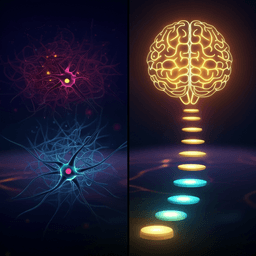
Psychology
Time-dependent consolidation mechanisms of durable memory in spaced learning
Y. Yang, Z. Huang, et al.
Emerging research shows time-dependent consolidation during 3-day spaced learning promotes cortical integration and replay—particularly in dorsal‑medial and medial‑temporal default mode network subsystems—and predicts durable 1-month memory, whereas massed learning shows more hippocampal replay. Research conducted by Yifeixue Yang, Ziyi Huang, Yun Yang, Mingxia Fan, and Dazhi Yin.
~3 min • Beginner • English
Introduction
The study investigates how time-dependent consolidation during spaced learning (multi-day intervals) supports durable memory compared to massed learning (single-day repetition). It asks which neural representations—particularly within the hippocampus and default mode network (DMN) subsystems—predict long-term retention and whether extended consolidation promotes hippocampal-to-cortical transfer and integration. The work addresses gaps in prior trial-based spacing studies that emphasize encoding mechanisms and short delays, by focusing on day-based spacing, multiple delayed retrievals (immediate, 1-week, 1-month), and both retrieval-evoked and resting-state neural signatures.
Literature Review
Prior research establishes the spacing effect as beneficial for memory durability and performance. Trial-based spaced learning has shown enhanced encoding-related activation and increased item-specific pattern similarity, but may overlook consolidation processes more prominent in day-based spacing. Consolidation theories propose transformation from detailed to gist-like memories and hippocampal-to-cortical reorganization over time. fMRI work has demonstrated increased retrieval-related neural pattern similarity following consolidation and changes in hippocampal-cortical functional connectivity during post-encoding rest that relate to subsequent memory. The DMN—partitioned into dorsal-medial (DMNdm), core (DMNcore), and medial-temporal (DMNmt) subsystems—is implicated in episodic memory, replay cascades, and integration, potentially serving as a cortical destination for stabilized memory traces. However, the precise roles of these subsystems and their relation to durable memory after spaced learning remained unclear.
Methodology
Design and Participants: Between-subject, day-based spacing design. Sixty-nine right-handed participants (38 females; age 22.49 ± 1.96 years) were recruited (35 spaced learning, 34 massed learning). Behavioral analyses included all 69; functional imaging analyses included 48 after exclusions (excessive motion and insufficient trial counts): 23 spaced, 25 massed. Ethics approval and informed consent obtained.
Materials: 70 picture-word pairs (10 practice, 60 experimental) created from neutral scene/object pictures (GAPED) and adjectives (MRC database; translated to three-character Chinese words). An additional 90 novel words (30 per test session) were used.
Procedure: Two learning conditions: spaced group learned across 3 days (2 blocks/day), massed group in 1 day (6 blocks). Each of 60 pairs was presented six times. Encoding (out of scanner): 5 s picture-word association followed by a 4.5 s success rating (1–5). Tests (in scanner) at immediate, 1-week, and 1-month delays, each with 60 learned and 30 novel words; response options: object, scene, uncertain, novel; ITI 2–10 s.
MRI Acquisition: 3T Siemens scanner, 20-channel head coil. T1 MPRAGE: TR 2530 ms, TE 2.98 ms, FA 7°, 1 mm isotropic. fMRI EPI: 33 slices, thickness 3.5 mm, gap 0.7 mm, TR 2000 ms, TE 30 ms, FA 90°, voxel 3.5 mm isotropic. Resting-state acquisitions 8 min (240 volumes); task acquisitions 15 min (450 volumes). Baseline resting-state before learning; rest and task fMRI at each test.
Preprocessing: Task fMRI (SPM12): slice-timing correction, motion correction (exclusion >2 mm or >2°), normalization to MNI, 3 mm voxels, high-pass filter (1/128 Hz), no spatial smoothing (preserve multivoxel patterns), motion regressors in GLM. Rest fMRI (DPABI): discard first 10 volumes, nuisance regression (6 motion, CSF, white matter), linear drift removal, bandpass 0.01–0.08 Hz.
Behavioral Metrics: D-prime (hit minus false alarm z-scores) per test. Durable memory defined as items correctly retrieved at both immediate and 1-month tests; retention rate = proportion of durable among immediate hits. Alternative definition using 1-week delay for sensitivity analyses.
ROIs: Bilateral hippocampus (AAL atlas); DMN subsystems (Yeo 17-network parcellation): DMNdm, DMNcore, DMNmt.
Analyses:
- Intertrial Similarity (RSA): Trial-by-trial GLMs produced beta images per trial. For successfully retrieved items, pairwise Pearson correlations of multivoxel patterns within each ROI formed representational similarity matrices (Fisher z-transformed); averaged off-diagonal entries yielded intertrial similarity.
- Temporal Similarity (RSA) for Durable Memories: For items durable across tests, correlations of multivoxel patterns for the same stimulus across immediate, 1-week, and 1-month (Fisher z-transformed). Mean across items/tests used as temporal similarity; also examined immediate–1-week subset.
- Replay Analysis: Retrieval-evoked neural activity templates constructed for durable and weak memories per ROI using GLMs (durable/weak as conditions; incorrect and novel as covariates). Correlated templates with framewise resting-state patterns (230 TRs; Fisher z). Threshold for replay defined by the 90th percentile of pooled correlations per ROI (validated at 88th, 92nd percentiles and 1.5 SD). Replay increment = post-encoding rest minus baseline rest counts.
- Multivoxel Resting-state Functional Connectivity (FC): For each hippocampus–DMN subsystem pair, computed voxel-wise correlation matrices, Fisher z-transformed, and averaged to obtain multivoxel FC at baseline and immediate post-learning. ΔFC = immediate minus baseline; also validated with univariate ROI-mean time-course FC.
- Whole-brain Searchlight MVPA: Using TDT, support vector machine trained/tested on half-splits of beta images for durable vs weak memories in spherical ROIs (radius 3 voxels) moved across the brain; voxel-wise accuracy maps generated and subjected to group-level one-sample t-tests (AlphaSim corrected p<0.05). Masks of significant regions intersected with hippocampus and DMN subsystems for subsequent RSA and replay analyses.
Statistics: Independent-samples t-tests for between-group differences; mixed ANOVAs for group × test effects; Spearman’s rho for correlations; exclusions of values beyond 2.5 SD. Multiple validation and control analyses conducted.
Key Findings
- Behavioral performance: No group difference in immediate d-prime (t(67)=0.11, p=0.915). Spaced learning showed higher d-prime at 1-week (t(67)=2.38, p=0.020) and 1-month (t(67)=2.95, p=0.004). Retention rate (durable memory) higher for spaced learning at 1-week (t(67)=2.87, p=0.006) and 1-month (t(67)=2.06, p=0.043).
- Intertrial similarity (immediate retrieval): Spaced > massed in DMNdm (t(43)=2.05, p=0.046), DMNcore (t(43)=2.30, p=0.027), DMNmt (t(44)=2.33, p=0.024); no difference in hippocampus (t(42)=0.50, p=0.617).
- Prediction of retention (1-month): In spaced learning, intertrial similarity correlated with retention in DMNdm (rho=0.43, p=0.044) and DMNmt (rho=0.45, p=0.032); no significant correlations in massed learning; between-group differences in correlation not significant (z=0.75, p=0.228; z=0.96, p=0.170).
- Temporal similarity (durable memories): Group differences absent overall; higher immediate–1-week temporal similarity for spaced in DMNcore (t(46)=2.10, p=0.041) and DMNmt (t(46)=2.08, p=0.044). In spaced learning, DMNdm temporal similarity correlated with retention for mean across tests (rho=0.46, p=0.027) and immediate–1-week (rho=0.47, p=0.023); between-group correlation differences non-significant.
- Replay (resting-state): Replay increment for durable memories >0 in spaced within DMNdm (t(22)=2.81, p=0.010) and hippocampus (t(21)=2.54, p=0.019); in massed, >0 only in hippocampus (t(24)=2.69, p=0.013). Between-group: DMNdm replay increment higher in spaced than massed (t(46)=2.10, p=0.041). For weak memories, replay increment >0 only in hippocampus after massed (t(24)=2.95, p=0.007).
- Hippocampus–DMNdm functional connectivity (immediate rest): Multivoxel FC lower in spaced than massed (t(46)=2.05, p=0.046). ΔFC (hippocampus–DMNdm) marginally correlated with retention in spaced (rho=-0.37, p=0.084). Validation with univariate FC: spaced < massed (t(46)=2.11, p=0.040); retention correlation significant in massed (rho=0.45, p=0.023).
- Exploratory time-course: After spaced learning, durable-memory replay increment >0 in hippocampus at 1-week (t(22)=3.14, p=0.005) and in DMNcore at 1-month (t(22)=2.80, p=0.033); hippocampal replay decayed by 1-month; between-group FC differences diminished over delays.
- Searchlight MVPA: Regions distinguishing durable vs weak memories in spaced localized mainly to DMNdm and anterior DMNcore; in massed to hippocampus, DMNmt, and posterior DMNcore. Within MVPA-derived masks, in spaced learning retention correlated with intertrial similarity (rho=0.46, p=0.027), temporal similarity (rho=0.44, p=0.036), and replay count (rho=0.44, p=0.038). Group differences in correlations significant for intertrial similarity (z=1.95, p=0.025) and replay (z=1.65, p=0.050), not for temporal similarity (z=1.53, p=0.062).
- Control & validation: Intertrial similarity differences (spaced > massed) persisted for incorrect trials across DMN subsystems; object trials showed higher similarity than scene in DMNdm. Replay findings robust across percentile thresholds (88th, 90th, 92nd) and weaker with 1.5 SD threshold. Using 1-week delay to define durability yielded weaker associations (e.g., DMNdm rho=0.38, p=0.085; DMNmt rho=0.36, p=0.096) and fewer spaced-specific MVPA regions.
Discussion
Extended consolidation intervals in spaced learning increase cortical neural integration (higher intertrial similarity in DMN subsystems) and spontaneous replay (particularly in DMNdm), which together predict durable memory at 1 month. The hippocampus exhibits replay for both spaced and massed conditions, with a tendency to replay weaker memories under massed learning, consistent with prioritization of less precise or subsequently forgotten items. Functional decoupling between hippocampus and DMNdm after spaced learning suggests reduced reliance on hippocampal support and stabilized cortical storage, aligning with systems consolidation models. Searchlight MVPA reveals that durable vs weak memory representations differ by strategy: cortical (DMNdm/anterior DMNcore) in spaced vs hippocampal/DMNmt/posterior DMNcore in massed, supporting a hippocampus-to-cortex transition with spacing. Collectively, findings demonstrate that day-based spacing enhances durable memory through time-dependent consolidation that favors cortical integration and replay over hippocampal mechanisms.
Conclusion
Spaced learning, relative to massed learning, induces higher cortical neural pattern similarity during immediate retrieval and greater spontaneous replay in DMNdm, both of which predict 1-month durability. Functional decoupling of hippocampus–DMNdm further supports cortical stabilization. These results indicate that time-dependent consolidation promotes neural integration and replay in cortex, underpinning durable memory after spaced learning and highlighting the importance of longer delay intervals for predicting durability. Future work should directly assess sleep-related consolidation mechanisms (e.g., EEG), capture encoding-phase neural dynamics in multi-day designs, increase item counts with independent testing schedules to mitigate retest effects, control for day-specific information load, and extend delay intervals beyond one month to refine durability definitions.
Limitations
- Sleep-related consolidation was not directly measured; future EEG or stereo-EEG studies are needed.
- Encoding-phase neural activity was not recorded in the multi-day design; differences observed for incorrect trials suggest possible encoding disparities that should be tested with fMRI during encoding.
- Repeated testing of the same pairs across sessions may affect memory durability and systems consolidation; future studies should increase items and test independently to minimize re-exposure effects.
- Information load differed between groups on the immediate test day (spaced vs massed), potentially influencing neural activity despite similar immediate performance; better controls are needed.
- The DMN’s association with boredom or fatigue could confound results; although behavioral parity at immediate test suggests minimal impact, this remains a consideration.
- The 1-month durability definition may not be optimal; longer delays (e.g., months to years) should be examined, noting potential very low retention rates at extreme delays.
Related Publications
Explore these studies to deepen your understanding of the subject.







